The ASRock Fatal1ty Z270 Gaming-ITX/ac Motherboard Review
by E. Fylladitakis on September 19, 2017 9:00 AM EST- Posted in
- Motherboards
- Intel
- ASRock
- Mini ITX
- Z270
- 7700K
- Z270 Gaming ITX/ac
The ASRock Z270 Gaming-ITX/ac Review
CPU Performance
For our motherboard reviews, we use our short form testing method. These tests usually focus on if a motherboard is using MultiCore Turbo (the feature used to have maximum turbo on at all times, giving a frequency advantage), or if there are slight gains to be had from tweaking the firmware. We leave the BIOS settings at default and memory at JEDEC for these tests, making it very easy to see which motherboards have MCT enabled by default.
As it can be summarized by all of the following graphs, the ASRock Z270 Gaming ITX/ac falls victim to its own default BIOS settings, as it is the only motherboard that does not have MCT enabled by default. As such, it always falls shortly behind all other Z270 motherboards, especially in multi-threaded performance tests.
Video Conversion – Handbrake v1.0.2: link
Handbrake is a media conversion tool that was initially designed to help DVD ISOs and Video CDs into more common video formats. For HandBrake, we take two videos and convert them to x264 format in an MP4 container: a 2h20 640x266 DVD rip and a 10min double UHD 3840x4320 animation short. We also take the third video and transcode it to HEVC. Results are given in terms of the frames per second processed, and HandBrake uses as many threads as possible.
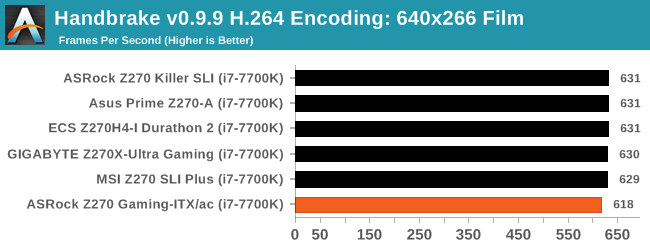
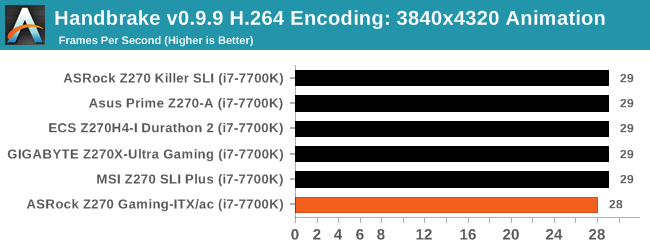
Compression – WinRAR 5.4: link
Our WinRAR test from 2013 is updated to the latest version of WinRAR at the start of 2017. We compress a set of 2867 files across 320 folders totaling 1.52 GB in size – 95% of these files are small typical website files, and the rest (90% of the size) are small 30 second 720p videos.

Point Calculations – 3D Movement Algorithm Test v2.1: link
3DPM is a self-penned benchmark, taking basic 3D movement algorithms used in Brownian Motion simulations and testing them for speed. High floating point performance, MHz and IPC wins in the single thread version, whereas the multithread version has to handle the threads and loves more cores. For a brief explanation of the platform agnostic coding behind this benchmark, see my forum post here. We are using the latest version of 3DPM, which has a significant number of tweaks over the original version to avoid issues with cache management and speeding up some of the algorithms.
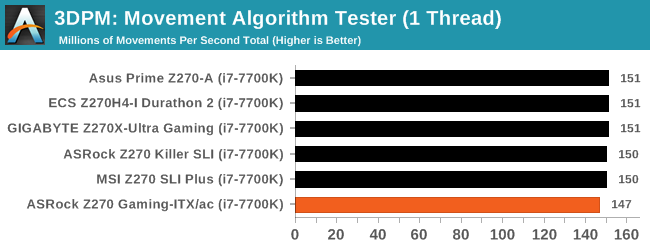
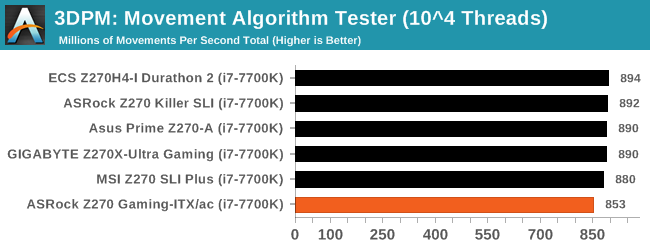
Rendering – POV-Ray 3.7.1b4: link
The Persistence of Vision Ray Tracer, or POV-Ray, is a freeware package for as the name suggests, ray tracing. It is a pure renderer, rather than modeling software, but the latest beta version contains a handy benchmark for stressing all processing threads on a platform. We have been using this test in motherboard reviews to test memory stability at various CPU speeds to good effect – if it passes the test, the IMC in the CPU is stable for a given CPU speed. As a CPU test, it runs for approximately 2-3 minutes on high end platforms.
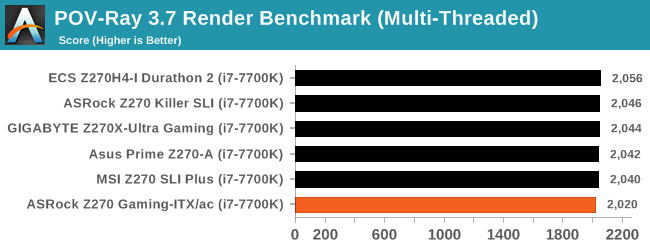
Synthetic – 7-Zip 9.2: link
As an open source compression tool, 7-Zip is a popular tool for making sets of files easier to handle and transfer. The software offers up its own benchmark, to which we report the result.
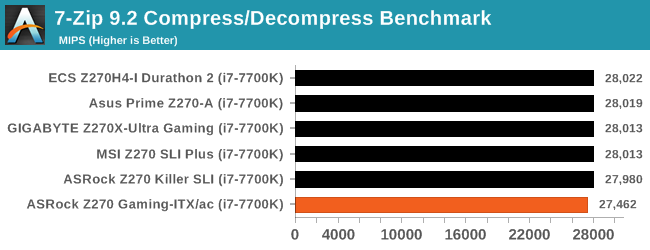










41 Comments
View All Comments
Gothmoth - Tuesday, September 19, 2017 - link
would love anandtech doing a in-depth VRM analysis like some youtube chanels do....i can read the specs myself on the manufacturer website.
spend some of that time on more useful things.
peterfares - Tuesday, September 19, 2017 - link
Why is there a SATA Express? I guess you can use it to connect U.2 drives right? But only at 2 lanes?DanNeely - Tuesday, September 19, 2017 - link
Probably equal parts design inertia, the sockets are cheaper than 2x sata because obsolete, and to support USB3.1g2 front panel devices. The latter needs 2 lanes of PCIe, so 1x slots aren't a good fit like for adding other forms of IO.BrokenCrayons - Tuesday, September 19, 2017 - link
It was sort of a cheap bandaid solution to the problem of SATA 3.0 bottlenecking contemporary SSDs that has never and probably won't ever take off since we now have M.2 interfaces instead. The idea was to quickly and cheaply double SATA 3.0 speeds in a backwards compatiable manner. Wikipedia has a pretty good article on it here if you want to know more:https://en.wikipedia.org/wiki/SATA_Express
OFelix - Tuesday, September 19, 2017 - link
I have the Z170 and used the feature to submit a support ticket direct from the BIOS.I was pleasantly surprised to receive a quick response from tech support.
On the Z170 I found that one of the fan headers would not allow speed control. Hopefully that has been fixed (review says that all fan headers support PWM).
Question: What devices could I buy today to use with SATA Express? Is it intended as internal or external expansion?
I want to build a system with multiple "personalities" by plugging in different external boot drives would thunderbolt or SATAe be suitable/better for this?
Thanks
Oxford Guy - Monday, September 25, 2017 - link
Good luck getting them to patch the BIOS for that board to fix the hyperthreading crash bug.Intel released the code to board makers in April. Here we are with AsRock sitting on its thumb.
punjabiplaya - Tuesday, September 19, 2017 - link
I've been running this board in my main rig since it launched. i7 7700k and a GTX1080 in a fractal nano. It's great.The_Assimilator - Tuesday, September 19, 2017 - link
Damn, that Thunderbolt chip is literally physically larger than the USB C port it's used for. Intel needs to slim that mofo way down if they want to fit it in the CPUs and/or south bridges, because that's the only way TB is ever gonna gain traction.DanNeely - Wednesday, September 20, 2017 - link
Yup. One of the reasons why really high speed IO is expensive, TB3 wasn't built into chipsets from the start, and why not all chipset USB ports are the fastest possible version is that doing it needs lots of transistors which means a relatively large amount of die size. You can see the same thing with USB3 only cards where the USB controller itself is the same size as the USBC port.ex
https://www.aliexpress.com/store/product/ASM1142-C...
only1jva - Tuesday, September 19, 2017 - link
I've owned this motherboard since March and it has begun to fail on me. After playing games like Civilization 6 and Xcom 2, the PC will completely freeze. After powering it down by holding down the power switch, I am unable to power it back on as the machine will turn on briefly then immediately shut down. It repeats this cycle over and over again. I have to wait half an hour to an hour before it turns back on completely.I'm running an i7-7700k AIO watercooler from Corsair, Asus GTX 1080, Corsair case. Not sure what the problem is with this thing but even if I can get into BIOS, it will freeze while in the BIOS screen. I've also tried all the released firmware versions for this board, they all behave the same.
so yeah, never trusting ASRock again.